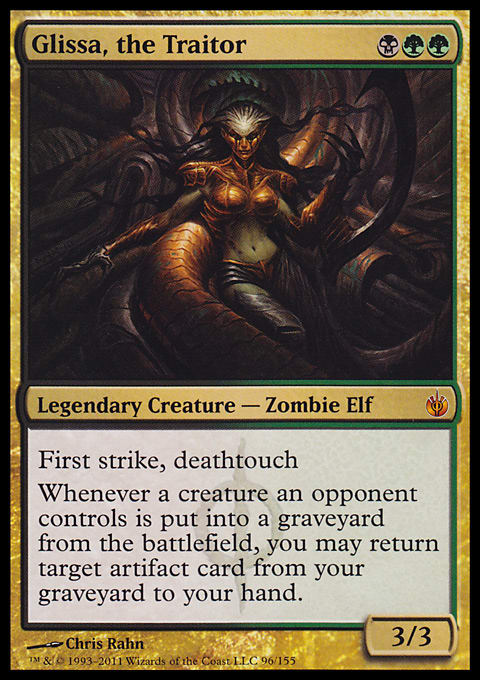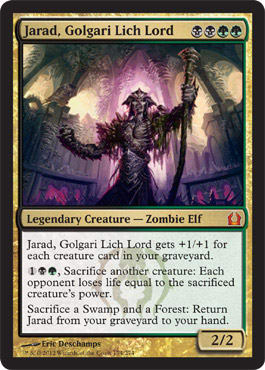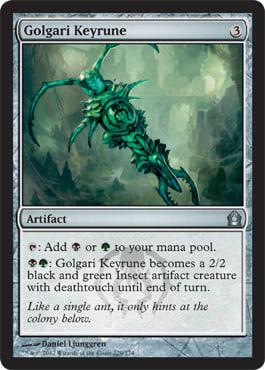So, Golgurgle week, huh? Black and green.
Deathtouch.
Scavenge.
Dredge.
Meh.
The B/G color combination is something I respect. The cards are there to build great multiplayer decks. Both colors have the ability to reuse their cards. In those long multiplayer games, that level of recursion can run other decks into the ground. The abilities to ramp and kill your opponents’ creatures with a wide variety of cards are great things. Many of my friends swear by B/G in their casual games. Some of the wildest cards in the game can be found in these colors. An argument can be made that Pernicious Deed is still the best card in multiplayer games. The combination of black and green packs a potent punch. Just ask my friend Daryl Bockett; he’ll tell you just how good Golgari is.
Yet I rarely play that combination of cards.
Why Glowgari Isn’t My Guild
 When I started playing, I was using the cards that I pulled from packs. I wasn’t buying singles. Initially, single cards weren’t available to me. There was no store that sold individual cards within eight hours of where I lived. Since I really didn’t have anything to trade and I had no idea what my cards were worth, trading really wasn’t an option either. Even when I did live near stores that sold singles, buying seemed like cheating; if you bought the cards you wanted, your decks would just be amazing! And besides, why would I ever pay $10 for a single card! Underground Sea isn’t worth that! Somehow, buying cards just seemed wrong.
When I started playing, I was using the cards that I pulled from packs. I wasn’t buying singles. Initially, single cards weren’t available to me. There was no store that sold individual cards within eight hours of where I lived. Since I really didn’t have anything to trade and I had no idea what my cards were worth, trading really wasn’t an option either. Even when I did live near stores that sold singles, buying seemed like cheating; if you bought the cards you wanted, your decks would just be amazing! And besides, why would I ever pay $10 for a single card! Underground Sea isn’t worth that! Somehow, buying cards just seemed wrong.
The result of never buying singles was that I never seemed to pull any good reanimation. Animate Dead, Exhume, and Reanimate were cards I played against but never seemed to find. Someone needs to be Lady Luck’s bitch, and when it came to black and green cards in the packs I pulled, I was that someone. When I tried to run black and green, I was ramping into Spirit of the Night or running a Zombie deck and using green to make the Zombies bigger. The decks were fine, but they never really abused the true strength of the Gagarini combination.
How Goggles Got Its Groove Back
Fast-forward many many years. I moved past my aversion to purchasing singles and obtained four copies of Glissa, the Traitor. I decided I had a way to abuse the graveyard-recursion strength of the Gargamel guild. When I realized just how many creatures (that opponents control) go to the graveyard in a multiplayer game, I discovered there was very little that I had to do to make Glissa work! I would rarely have any artifacts in my graveyard as long as Glissa was in play (I think it was “in play” then. Oh, I am so old!). I focused the deck on a suite of artifact creatures that Glissa could bring back again and again. I happened to own a Vulturous Zombie that would also take advantage of all the dying going on, so that was added in as well. Since some of the creature options were a little underwhelming, I also threw in a few pieces of Equipment to make my creatures just a little more deadly. It didn’t hurt that Glissa could bring the Equipment back either!
After a little work, I wound up with this:
"Glissa’s Got Graveyard Get Up and Go"
- Creatures (23)
- 1 Ana Disciple
- 1 Drift of Phantasms
- 1 Golem Artisan
- 1 Utopia Tree
- 1 Vulturous Zombie
- 2 Birds of Paradise
- 1 Creepy Doll
- 1 Shimmer Myr
- 2 Etched Champion
- 2 Steel Hellkite
- 2 Wurmcoil Engine
- 4 Sylvok Replica
- 4 Glissa, the Traitor
- Spells (12)
- 1 Counterspell
- 1 Dissipate
- 1 Remove Soul
- 1 Turn Aside
- 1 Bonehoard
- 1 Darksteel Plate
- 2 Sword of Feast and Famine
- 4 Executioner's Capsule
- Lands (25)
- 4 Forest
- 2 Bayou
- 2 Verdant Catacombs
- 3 Tropical Island
- 3 Underground Sea
- 3 Tree of Tales
- 4 Seat of the Synod
- 4 Vault of Whispers
“Blue!? Really!?” I know, I know! The early deck was working only sporadically. It just wouldn’t run smoothly without Glissa being in play. It could pull out wins without her, but too often, my plans—and course to victory—came undone when she disappeared. I brought in the blue cards to protect her and give my opponents the sense that I could stop whatever they were doing. Admittedly, with only four counters, I was very limited in when I could actually stop an opponent. In spite of that limitation, with some careful play, I had a counter exactly when I needed it in several games. My opponents started to believe the number of counters I had in the deck was far greater than it actually was. They began to think twice before playing their game-changing spells. This left me with more opportunities to really get the deck going.
 Another significant change this deck has seen was the removal of Mindslaver. I ran it mostly to see how it would play out. I’m generally opposed to combo decks, and the Mindslaver lock did nothing to change my mind. Locking an opponent right out of the game wasn’t any fun for him and was only moderately fun for me. It turned a deck that used recursion to gain long-term card advantage into a combo deck. The worst part was that even when the combo was working, it took numerous turns to kill my opponents. Locking out players is bad enough; making them wait another fifteen or thirty minutes for you to finally kill them is just revolting. Mindslaver had to go.
Another significant change this deck has seen was the removal of Mindslaver. I ran it mostly to see how it would play out. I’m generally opposed to combo decks, and the Mindslaver lock did nothing to change my mind. Locking an opponent right out of the game wasn’t any fun for him and was only moderately fun for me. It turned a deck that used recursion to gain long-term card advantage into a combo deck. The worst part was that even when the combo was working, it took numerous turns to kill my opponents. Locking out players is bad enough; making them wait another fifteen or thirty minutes for you to finally kill them is just revolting. Mindslaver had to go.
“So, your Golgari Golrossi deck for this week is a B/U/G wedge? That’s really the best you could do?”
Before the mob builds, just stay with me for a second.
G/B and the Heebie Geebies, a.k.a. “He went to Jarad’s”
After I accumulated a few Sealed pools worth of Return to Ravnica cards, I discovered that I had three copies of Jarad, Golgari Lich Lord. It would seem that Jarad combos well with Glissa. When an opponent’s creature is about to die, I could use Jarad’s ability to sacrifice a creature, preferably an artifact creature, and each of my opponents would lose life equal to the creature’s power. Since it is in the graveyard when the opponent’s creature dies, Glissa will let me put it back in my hand, letting me bring it back into play on the next turn. Admittedly, with creatures being taken out of the graveyard, Jarad is never going to grow very big, but with the graveyard hate that is starting to show up in my metagame, relying on cards in the graveyard for too long is a dangerous thing.
Jarad Took My Blues Away
With Jarad, I took another look at my B/U/G list and started thinking about ways to shoehorn him into the deck. How difficult could it be to remove a few underperforming cards and add Jarad to the mix?
Part of my concern was adding another 4-mana creature to the deck, since most of the cards I would be looking to remove would cost less. On top of that, I was adding a ![]()
![]()
![]()
![]() card to the deck. Mana requirements like that are often dangerous for a three-color deck. I had loaded the deck with duals, so it shouldn’t have been too big an issue, but it was a concern nonetheless.
card to the deck. Mana requirements like that are often dangerous for a three-color deck. I had loaded the deck with duals, so it shouldn’t have been too big an issue, but it was a concern nonetheless.
It was at this point when I realized that there were seven blue cards in the deck. Surely I could find a way to protect Glissa (and now Jarad) using just black and green! Black and green must have some inventive way to keep your key cards from being constantly cropped.
How about rather than protecting them, I simply recur them when they are targeted? Or have ways to find another if the first copy is destroyed? The easy way to find a card in your library with black is to use any tutor. Rather than run tutors, I opted to stay on-theme and use Solemn Simulacrum instead. I know it doesn’t find the cards we’re looking for, but it thins out the deck like nobody’s business, and it draws extra cards. With Jarad in the deck now, I expect my creatures will be entering and leaving the battlefield more frequently, and the Sad Robot loves changing zones.
The other card was Beacon of Unrest. I love the flexibility of this card. Not only will it pull Jarad or Glissa out of the graveyard, but it can also go and grab cards in other people’s graveyards as well! It limits recursion efforts from your opponents and will occasionally give you some opponent’s juicy fatty that will splat all over your opponents when you sacrifice it using Jarad’s ability!
My almost-Gollumgari deck has been transformed!
"Golgari – Subway Style"
- Creatures (25)
- 2 Vulturous Zombie
- 1 Creepy Doll
- 1 Golem Artisan
- 1 Shimmer Myr
- 2 Solemn Simulacrum
- 2 Steel Hellkite
- 2 Wurmcoil Engine
- 3 Etched Champion
- 4 Sylvok Replica
- 1 Glissa Sunseeker
- 2 Jarad, Golgari Lich Lord
- 4 Glissa, the Traitor
- Spells (11)
- 2 Beacon of Unrest
- 1 Bonehoard
- 1 Darksteel Plate
- 1 Golgari Keyrune
- 2 Sword of Feast and Famine
- 4 Executioner's Capsule
- Lands (24)
- 5 Forest
- 5 Swamp
- 2 Verdant Catacombs
- 4 Bayou
- 4 Tree of Tales
- 4 Vault of Whispers
There were some changes other than just removing blue and adding Solemn and Beacon of Unrest.
Golgari Keyrune – I removed Birds of Paradise and Utopia Tree, and I wanted to add back some mana ramp. The Keyrune did that, and it acted as another artifact creature.
Etched Champion and Vulturous Zombie – I added another copy of each creature, mostly because I was never sad to draw them. Both cards won games and often gave me a fighting chance when things were going badly. The Etched Champion has been equipped to the Sword of Feast and Famine more than any other creature in this deck. He becomes very difficult to stop once equipped. The Vulturous Zombie isn’t particularly synergistic with Glissa, but the card is such a powerhouse in multiplayer that it seemed wrong not to include it initially, and it seems wrong not to add another copy!
Glissa Sunseeker – The Sunseeker may not make the final cut, but I have wanted to see how effective it would be considering the minimal cost to activate. The Sylvok Replicas probably do a good enough job on their own, so this slot could change.
Lich Lord: Link to Long-term Laugher?
“So, does the deck work?”
The deck has yet to see play, so you can expect an update some time in the future. While this deck is technically Golgiggle, there are a lot of artifact creatures running around. I have a couple other B/G ideas (Corpsejack Menace isn’t in a deck yet!), so you can expect to see another deck at some point as well. I will do everything I can to overcome my Golgari complex.
Bruce Richard
























